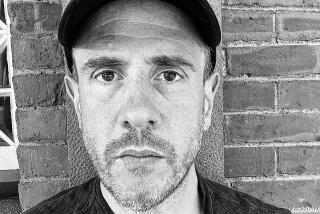Bicoastal
New York
Like jaywalking or a forecast of snow across the Southland, the announcement several weeks ago that the New Yorker magazine now has more subscribers in California than in the state of New York didn’t feel right.
But there it was. For the six-month period that ended Dec. 31, California had a total paid circulation of 167,583, compared with New York’s 166,630, according to David Carey, the New Yorker’s publisher and vice president. Though the tri-state area (New York, New Jersey and Connecticut) accounted for the highest percentage of readers in any market, San Francisco and Los Angeles finished second and third, at 65,000 and 54,000, respectively.
What this will do to the well-worn cliches about California is uncertain. The Atlantic Monthly also has more subscribers here than in any other state.
Perhaps the New Yorker figures can be attributed to nothing more profound than this: People keep moving here. California, the state, has many more people than New York, the state -- 34.5 million compared with 19 million, according to the 2001 census estimates. Some of these people, to be sure, are expatriates who retain their virtual New York-ness locally. Here in L.A., this includes talking about how much better the (insert foodstuff/activity/whatever) is in New York and subscribing to the New Yorker. Plus, being able to cite New Yorker stories can help at certain parties.
Still, in recent years, the magazine has by degrees seemed to tilt its coverage to the West Coast. There have been pieces on the Iranian emigre community in Southern California, the quirky history of the Golden Gate Bridge as it relates to suicide jumpers, the annual biker rally in Hollister, the L.A. River and, of course, the gubernatorial bid and reign of Arnold Schwarzenegger.
In his office 20 floors up in the Conde Nast building at Four Times Square, New Yorker Editor David Remnick regarded the curious publishing statistic as just that -- curious, in a passing way, the firewall between editorial and marketing firmly in place.
As guardian of the magazine world’s most burnished weekly report of ideas, culture and politics, Remnick stressed that it is not his job to bend toward what the numbers say. So, if Californians love the New Yorker in greater numbers than New Yorkers these days, so be it.
“It’s not as if our circulation has dipped in New York,” Remnick said. “The best thing is that close to 80% of our subscribers re-up every year.” In the magazine world, he said, “it’s numbers that are equivalent to UCLA basketball in the ‘60s.”
Because he is a polite person, gentle-seeming, Remnick offered a few theories on the magazine’s West Coast following. They had to do, mostly, with how the world has changed -- more global, less local. He noted that the New Yorker has long had writing on California. John McPhee, for instance, whose books include “Assembling California,” a geological history of the region.
“It retains a New York-ness, to be sure,” Remnick said of the magazine. “We have ‘Goings on About Town,’ a front-of-the-book listing of cultural events in New York. ‘Goings on About Town’ is this town, not Sacramento or San Bernardino. All the same, I think California is enormously important, and not just show business.”
New York, Remnick said, is probably no longer the center of the universe as depicted in the 1976 Saul Steinberg New Yorker cover cartoon “View of the World From 9th Avenue” -- Manhattan buildings in the foreground and the rest of the country represented by a flat patch of land, the Pacific Ocean in the distance.
The point of view was even more insular in 1925, when the magazine began, in Remnick’s words, as “a local magazine, founded by New Yorkers and people who had arrived in New York.” It was of a time and place synonymous with the Jazz Age, before world wars conspired to make the magazine more national in focus, he added.
“I get around; the magazine should get around,” he said. “Whether [it’s] foreign or national reporting or fiction or arts coverage. I think in the old days it’s fair to say that the architecture critic was about being the architecture critic of buildings in New York, with occasional forays elsewhere. Now, Paul Goldberger is just as likely to be reviewing ... Disney Concert Hall as he is to be looking at the latest Trump catastrophe.”
This week, the New Yorker is a double issue on humor. Among the stories are a profile of Hollywood director Harold Ramis and a piece on the Farrelly brothers’ lifelong love of the Three Stooges.
The notion that the magazine was tarnishing its hallowed image with too much coverage of pop culture and Hollywood dogged Remnick’s predecessor, Tina Brown, who ran the magazine for six years before Remnick took over in 1998.
Brown, only the fourth editor in the magazine’s near-80-year history, glitzed up its pages and was both credited with and criticized for the brash stabs at glamorization. Remnick, the author of several books, including the Pulitzer Prize-winning “Lenin’s Tomb” on the fall of the Soviet empire, has since become known as the more balanced steward of the New Yorker’s return to excellence.
But he hasn’t exactly put a halt to the coverage of Hollywood. The Hollywood Issue, the marketing-friendly special begun under Brown, still exists. But it exists on the New Yorker’s terms, Remnick said, meaning free of the publicity imperialism movie studios have grown accustomed to enforcing. Naturally, this only makes Hollywood want a New Yorker profile more.
“One thing you can say is that while New York and New Yorkers probably have a right to call New York City a cultural capital, there has been a big decentralization of culture in the country that’s been going on for decades, not least the establishment of Hollywood,” he said. “You are now seeing the decentralization of Hollywood itself, in Vancouver and so on. The literary world is no longer all centered between the southern tip of Manhattan and the northern reaches of Harlem. It hasn’t been for a long, long time.”
Recently, the magazine hired Caitlin Flanagan, who lives in Los Angeles, to write about domestic life in America. Connie Bruck, who writes about politics and business, lives here. Tad Friend, who pens “Letter From California,” lives in Brooklyn but comes to California frequently.
That doesn’t include local contributors in various genres -- among them fiction writer T.C. Boyle, humorist Steve Martin, and cartoonist Bruce Eric Kaplan (who also writes for the HBO series “Six Feet Under”).
The shift in readership “was nothing that was done editorially,” said Carey, the publisher, who graduated from UCLA.
Carey indicated the magazine, whose paid circulation approaches 1 million, is healthy financially after years of losing money, but he declined to elaborate. (The New Yorker, it was reported, lost an estimated $11 million in 1997, the year before Remnick took over for Brown.)
Carey, trumpeting the magazine’s health, said the average age of a New Yorker reader has dropped from 49 to 44. Further, more than 33% of the magazine’s audience is between 18 and 34. “The next generation is teed up nicely to become readers.”
The magazine has also been holding public events to animate the brand, as Carey put it. Last month, longtime staffer Lillian Ross did a live interview with Robin Williams at the Silent Movie Theater in the Fairfax District, an offshoot of “The New Yorker Nights” festival begun in New York four years ago.
“It may just be that it’s a good magazine,” said social satirist Paul Krassner, the New Yorker who moved to California in 1971. “It transcends geography,” Krassner said, adding that, unlike reading Vanity Fair, “you don’t feel as though you’ve been immersed in perfume.”
More to Read
Sign up for our Book Club newsletter
Get the latest news, events and more from the Los Angeles Times Book Club, and help us get L.A. reading and talking.
You may occasionally receive promotional content from the Los Angeles Times.






